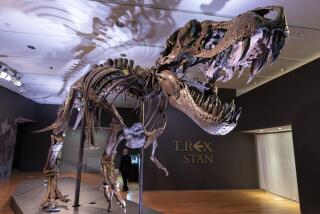Newly discovered dinosaur had an eagle face, was the size of a crow
More than 100 million years ago, when the grasslands of Montana were dotted with redwoods and ferns, there lived a diminutive dinosaur the size of a crow with a face that resembles an eagle.
All that remains of the little guy today is a fossilized skull and some teeth, but that was enough for paleontologists to identify the newly named Aquilops americanus as the earliest horned dinosaur to be found in America.
The name Aquilops is a hybrid. It is derived from the Latin word aquila, which means “eagle,” and the Greek word ops, which means “face.” The “americanus” is a nod to the fact that it was found in America.
The skull of Aquilops is about 3.5 inches long and would easily fit in the palm of your hand. When the fossil was discovered in southern Montana in the late 1990s, however, it looked like just a few teeth sticking out of a rock.
Researchers say the full-bodied dinosaur was likely the size of a crow or a raven.
“On the scale of dinosaurs it is not the smallest,” said Andrew Farke, of the Raymond M. Alf Museum of Paleontology. “There are ones that are half that size, but in terms of horned dinosaurs, it is one of the smallest we know.”
Farke is the lead author of a paper describing Aquilops that was published this week in the journal PLOS One.
Aquilops did not have any features resembling horns, except perhaps some cheek spikes, but it is still considered a horned dinosaur because it is more closely related to dinosaurs such as Triceratops and Pachyrhinosaurus that had elaborate horns and frills. Some of the features that horned dinosaurs share include beaks, and a bone on the front of their face called a rostrium.
Aquilops was a plant eater, and Farke said it likely used its hooked beak to nip at vegetation. The researchers also believe that this particular specimen was an adolescent based on the texture of its skull bones and how they fit together.
The find is particularly significant because Aquilops lived nearly 20 million years before the next oldest horned dinosaur that was found in America, and yet, it does not seem to be an ancestor of those later horned dinosaurs.
“It is far more closely related to dinosaurs coming out of Asia,” said Farke.
In the paper, Farke said, his colleagues suggest that this find shows that Aquilops or its ancestors probably immigrated to America from Asia during the early Cretaceous, which started 145 million years ago and ended 66 million years ago. But other mysteries linger.
“One thing I want to know is when the ancestors of the other North American horned dinosaurs immigrated,” Farke said. “Was it the same time as the Aquilops or was it later?”
It’s a question that only more fossil discoveries can solve.
Science rules! Follow me @DeborahNetburn and “like” Los Angeles Times Science & Health on Facebook.







